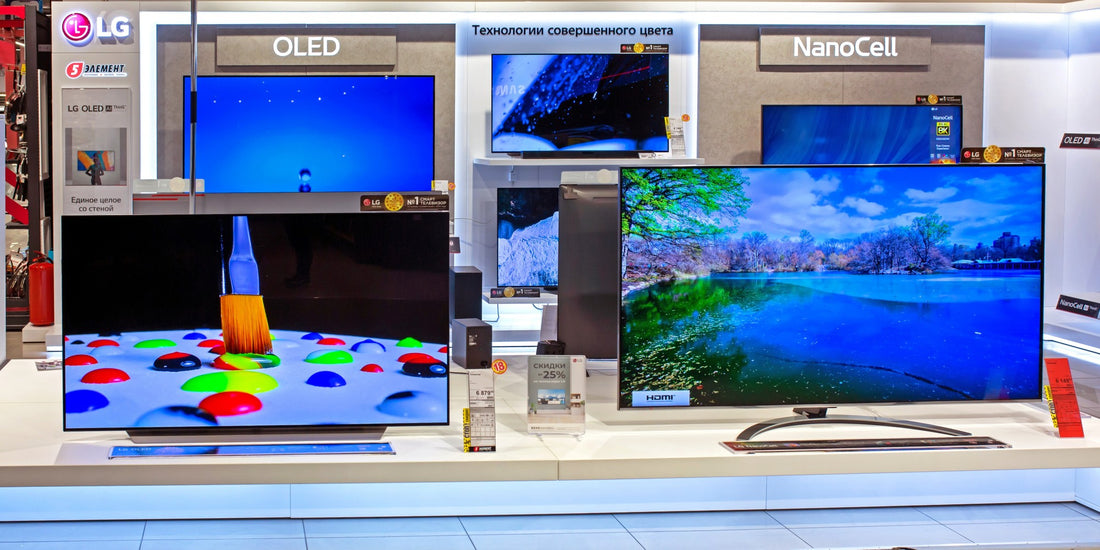LED vs OLED vs QLED - Lifespan & Which One To Prefer
Are you stuck on buying a new TV and unaware of the different technologies? Although they appear similar to you, marketing terminology like OLED, QLED, and LED refers to distinct panel types.
The pros and disadvantages of each technology for picture quality vary, and this page describes the unique qualities of QLED, OLED, and LED TVs. Let's take a deep look at these technologies without wasting any time.
Understanding OLED, QLED, and LED Technologies
OLED
OLED TVs can control each pixel's brightness individually. This enables them to display only blackness when they are fully turned off. They have wide viewing angles and excellent picture quality as a result.
- Why should you buy it?
Anyone can afford it, except those who intend to watch a lot of static content or use it as a PC monitor. The transparent OLED television is one type of the OLED TV. Although its cost is higher than the common television, it can provide a transparent screen and can be used as a computer monitor.
QLED
Traditional LCDs are illuminated by LEDs in QLED TVs. A quantum dot layer filters the light between the LCD layer and the backlight to provide more vibrant and pure colours.
A few firms, notably Samsung and TCL, use the word "QLED" in their marketing to refer to their quantum dot televisions.
- Why should you buy it?
Those seeking the best colours available should get it.
LED
Light-emitting diodes, or LEDs, were the first to enter the TV industry before QLEDs and OLEDs.
They illuminate an LCD panel with LEDs. A VA panel, which often has a high contrast ratio and restricted viewing angles and may get quite bright, is found in many LED TVs.
- Why should you buy it?
The majority of people shopping for TVs today should purchase them. The best value is in LED TVs, which come in many sizes.
Comparison of LED vs OLED vs QLED
LED
This is partially true; LED TVs have completely replaced LCD TVs. Only a new variety of LCD TVs exist, LED TVs. Their foundation lies in LCD technology, which comprises sandwiching a liquid crystal solution between two sheets of polarizing material.
LCD TVs use CCFLs to provide backlighting. LCD TVs were bulkier than the latest LED TVs since they are generally larger than LEDs. Compared to CCFL, LEDs are smaller, use less electricity, and have brighter light levels. In the long term, LED TVs are more dependable because they live longer.
It's crucial to consider the backlighting technology when purchasing an LED TV. These days, edge-lit and full-array LED systems are the most widely accessible. Today's LED TVs often use an IPS panel, but VA panels are also possible if you're shopping for a gaming monitor that makes it better than LCDs.
Lifespan:
In general, LED lights should last you just about 14 years if you use them for 10 hours a day.
QLED
The technology is appealing to hear about and show off; it is comparable to conventional LED TVs but has certain benefits. The extra Quantum Dot filter produces brighter and more accurate colors. The backlighting of a QLED TV is also where the more significant modifications begin. QLED TVs have a blue backlight, while ordinary LED TVs have a white one.
The red and blue dots that make up the quantum dot filter are in contact with this blue light. To create images on the screen, the RGB light from the Quantum filter is sent via an LCD filter and color filter glass. Better color rendition is achieved by the precise control of light made possible by these dots.
Additionally, they increase brightness levels without compromising the content's color saturation. It has more benefits compared to LEDs.
Lifespan:
With proper care, QLED TVs may easily live beyond 7 years and they're even more likely to do so.
OLED
When necessary, an OLED TV may completely turn down and manually regulate each pixel. Dark blacks, increased contrast, and vivid colors are the end effects.
The best TV technology for you primarily depends on your preferences and financial situation. Conventional LED TVs are excellent for regular TV binges and are usually more reasonably priced.
Starting from reasonable prices, you can even get some excellent ones with 4K resolution if you go a little further. Without a doubt, OLEDs provide complete perfection. Their pricing is relatively low compared to others, and their picture quality is unmatched.
Lifespan:
"Forever TVs" is a nickname given to OLED TVs. If you watch them for eight to ten hours a day, they should last you at least 10 years.
Conclusion:
Are you looking for "LED vs OLED vs QLED - Lifespan & which one to prefer?" This article can be a sweet spot to clear up any confusion.
All in all, several panel kinds have emerged due to advancements in TV technology, each having pros and cons of their own. Perfect blacks and broad viewing angles are achieved with OLED TVs, which vary from QLED and LED TVs in that each pixel can be turned on or off independently.
Yet LED and QLED TVs typically increase brighter; the latter also shows a broader color spectrum when watching HDR material. Lastly, while LED/QLED TVs do not experience irreversible burn-in, OLED TVs can.

